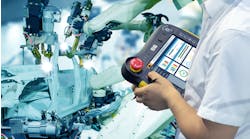The manufacturing industry is a key pillar of economic growth and innovation, playing a vital role in driving progress across various sectors. Over the years, it has witnessed a multitude of transformations driven by technological advancements, including digitalization.
Technology continues to redefine the manufacturing industry, offering unprecedented opportunities and challenges. The impact of digitalization on the manufacturing sector is now more profound than ever before, but navigating the opportunities and challenges offered by digitalization is crucial for businesses to remain competitive in a rapidly evolving global market.
See also: Simulation, AI, and their roles in manufacturing's future
Sometimes it feels like manufacturers view digitalization as a replacement for shopfloor workers rather than to enhance their productivity and skills sets. In failing to invest in the digitalization of crucial shopfloor operations, and more importantly making it work to optimize people and processes, manufacturers miss out on the real benefits of digital transformation, including improved workforce time management, new business intelligence, and greater productivity.
Digital transformation should be human-centric, supporting and enhancing people to achieve more rather than replacing them. Manufacturers should embrace digitalization that augments workers’ performance to deliver shop floor speed, flexibility, and visibility—enabling a ‘connected’ workforce.
Manufacturers globally recognize the potential of digital transformation, but often struggle to know where to begin the process and deliver ROI. According to a 2023 survey by McKinsey, a majority (56%) of respondents said their organizations have achieved most or all their transformation goals, however only 12% report they have sustained these goals for more than three years. Additionally, an average 42% of financial benefits are lost during the latter stages of a large-scale change effort.
From a competitive point-of-view, manufacturers that fail to get their data in order risk being left behind by their rivals, new research from Hexagon reveals. A global survey of more than 500 manufacturing leaders, conducted by Forrester Consulting and commissioned by Hexagon, found that 98% of manufacturers report at least one issue with data within their organization, which is stifling innovation and impeding the roll-out of advanced manufacturing technologies like real-time collaboration, AI and automation.
See also: Building a culture of everyday innovation
It’s well-documented that you need a good strategy and approach to achieve a successful digitalization program, however, options can be limited so how do you start and how do you ensure that your effort and investment lives and grows, and that it sticks?
From the get-go, it is vital to have the buy-in of the C-Suite to provide support right from sign-off stage to ongoing management and continual improvement. Without this support, early interest and enthusiasm can easily wane.
Work with what—or rather who—you have
Forging a collaborative culture within an organization is essential as digital transformation always involves getting different departments and different groups within departments to work together in a more coherent and effective way. Effective change management can identify people who are most resistant to change and provide them with the right training and education to turn them into digital transformation advocates.
It's a mistake to think of digital as something separate from what the organization is doing today, requiring an entirely new culture. Embracing and understanding the goals of digitalization and setting expectations delivers a realization that while culture change is almost always necessary, it is better to focus on forming new habits and ways of working within the existing culture make it more effective.
See also: With AI, the time is now, say manufacturing technologists, futurist, 'evangelist'
Many organizations invest in digitalization and change management initiatives without implementing the appropriate oversight to see the initiative succeed. Digitalization needs to pivot quickly to changing market conditions and customer demands.
One of the key advantages of investing in digitalization is the ability to achieve scalability and flexibility, allowing businesses to easily adjust their operations to meet changes in business operations. Whether it's expanding to new markets, accommodating growth, or responding to unforeseen circumstances, digitalization provides the tools necessary to stay adaptable and competitive.
Using automation to cut the administrative burden
Automation and digitalization are closely linked. A business that seeks to digitalize its workflow can leverage automation to update job roles and transform entire business processes from end to end. This is a priority because, while early technology improvements saved employees time in their daily work, the number of administrative tasks required to do the work often undermines productivity.
For example, repetitive tasks like data entry and file organization take up valuable time. Automating these tasks can give this time back to employees.
Report: American manufacturing may need 3.8 million new workers by 2033
Recently launched, Hexagon’s Advanced Manufacturing Report uncovers evidence of fundamental shifts in how high-value products are designed and manufactured through three fundamental digital enablers—data quality and availability, workforce collaboration and empowerment, and automation.
The survey of 524 manufacturing leaders, conducted last May, revealed that nearly 40% of manufacturers are automation laggards and risk being left behind their rivals that are prioritizing data-driven productivity and automation.
Implementing end-to-end process automation can free their employees from the tedium of tending to these administrative duties each day. This enables them to refocus their unique expertise and talents on projects that they find engaging and that the company finds strategically advantageous.
As illustrated below, digitalization builds on success (stacking benefits), especially when a business uses the time saved from a successful workflow automation project to automate even more processes and functions throughout the company. By doing so, businesses can steadily create even more organizational capacity to innovate and evolve.
See also: Industrial OT widely vulnerable to intrusion, survey finds
By implementing digitalization and achieving operational excellence using connected worker solutions at a workshop or plant level becomes a blueprint to adapt and to apply the knowledge to local requirements at other sites. Common worker instructions, KPI’s and user experience to be replicated and scaled to provide business-wide transformation of key applications and processes.
Manufacturing ecosystems consist of diverse facilities, from component suppliers to fabricators and key suppliers to OEN’s with multiple facilities, with teams collaborating remotely on product development. Both internal and external silos can hinder progress, making digitalization essential for breaking down these barriers. McKinsey estimates that digital collaboration could unlock over $100 billion in value for the industry—meaning manufacturers must adopt digitally connected solutions to promote collaboration and interaction across departments.
See also: Easing into AI and machine learning
Having an effective and repeatable digital strategy with data management lends itself to more efficient communication and collaboration with other teams—be those external or intra-site within a company.
In response to evolving industry trends and challenges, manufacturers must seek out solutions that link people, technologies, and data to expedite innovation and bring ideas to fruition faster than ever before. By navigating these trends through technology, manufacturers can stay ahead of the curve and unlock new possibilities.



